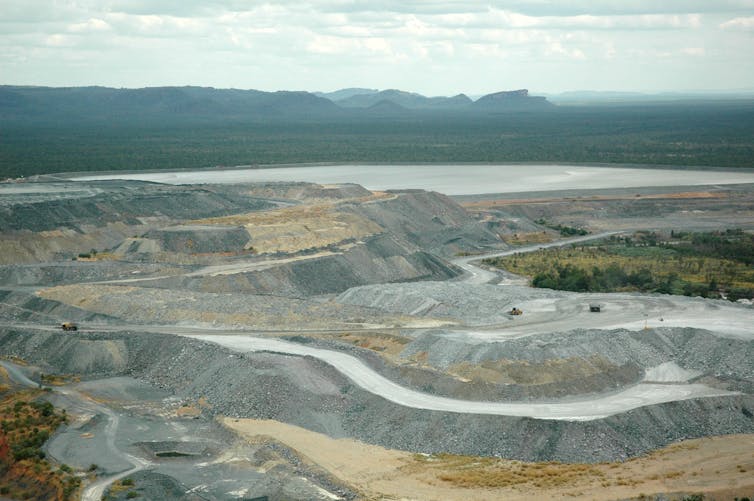The uranium mine in the heart of Kakadu needs a better clean up plan
- Written by Rebecca Lawrence, Affiliate, Sydney Environment Institute; Honorary Associate, Macquarie University, Macquarie University
Can a uranium mine be rehabilitated to the environmental standards of a national park and World Heritage site?
That’s the challenge faced by the controversial Ranger uranium mine inside Kakadu National Park.
But our new research report found the document guiding its rehabilitation is deficient, and urgent changes are needed for the heavily impacted mine site to be cleaned up well.
Kakadu has been a national park since the 1970s, but the Ranger mine, while surrounded by Kakadu, has never formally been part of the park. This classification is in the interests of resource extraction, and has failed to recognise or protect the area’s cultural and environmental values.
Kakadu National Park encompasses a precious natural heritage. It protects valuable ecosystems of outstanding value, diversity and beauty, and contains the world’s richest breeding grounds for migratory tropical water birds.
Read more: Australia's problem with Aboriginal World Heritage
Recent diggings and studies have documented at least 65,000 years of continuous human habitation at a site on the land of the Mirarr people – this is currently the oldest occupation site in Australia.
How was the mine developed?
The boundaries of Kakadu National Park were conveniently drawn around the Ranger mine site through a series of political and administrative negotiations following the Fox Inquiry, which gave a cautious green light for the Ranger operation.
Likewise, Ranger was excluded from the requirements of the Aboriginal Land Rights Act that would have otherwise given the Mirarr people the right to say no to the mine.
Now, as the mining stops and the repair begins, mining companies and government regulators are being tested on their environmental commitment, and capacity to make meaningful change.
Read more: Treasure from trash: how mining waste can be mined a second time
But rehabilitating what is essentially a toxic waste dump is no easy task.
And the inadequacy of the Energy Resources of Australia’s Mine Closure Plan – the key document guiding the rehabilitation – shows they are failing this test so far.
 The Ranger uranium mine, owned by Energy Resources Australia (ERA), sits in the heart of the world heritage listed Kakadu National Park.
AAP Image/Tara Ravens
The Ranger uranium mine, owned by Energy Resources Australia (ERA), sits in the heart of the world heritage listed Kakadu National Park.
AAP Image/Tara Ravens
Problems with the Mine Closure Plan
Our new research report – jointly conducted by Sydney Environment Institute and the Australian Conservation Foundation – examines the Mine Closure Plan and finds it is seriously wanting in key areas.
These include significant data deficiencies regarding management of mine tailings (mine residue), land stability, and modelling of toxic contaminants likely to flow off site into Kakadu National Park.
The Mine Closure Plan is almost completely silent on crucial governance questions, such as the Ranger mine’s opaque regulatory processes and rehabilitation, and current and future financing – especially in relation to future site monitoring and mitigation works.
Read more: Ranger's toxic spill highlights the perils of self-regulation
After the price collapse following the Fukushima nuclear crisis, times in the uranium trade have been tough. Coupled with a mandated end to commercial operations by early 2021, Rio Tinto has accepted the era of mining has now been replaced by the need for rehabilitation.
But the challenge for Energy Resources of Australia and Rio Tinto, who own and operate the mine, is not simply to scrape rocks into holes and plant trees. It is to ensure radioactive and contaminated mine tailings are:
physically isolated from the environment for at least 10,000 years [and that] any contaminants arising from the tailings will not result in any detrimental environmental impacts for at least 10,000 years.
These are time-scales of epic proportions, yet the Mine Closure Plan says little to assure the public this can be achieved.
In fact, Energy Resources of Australia concedes it won’t actually be possible to monitor and measure this over the next 10,000 years, so a model will be required instead. But this model has not been publicly released.
 Kakadu is home to more than 280 different types of birds, such as the white bellied sea eagle.
Shutterstock
Kakadu is home to more than 280 different types of birds, such as the white bellied sea eagle.
Shutterstock
Rehabilitation success is determined by the mining company
And this speaks to a broader problem with the whole process: the success of the rehabilitation will be judged by criteria created by the mining company.
It is naive to assume a mining company is best placed to propose their own rehabilitation criteria, given their corporate imperative to reduce rehabilitation costs and future liabilities.
And the stakes here are very high. The rehabilitation of Ranger will be a closely-watched and long-judged test of the credibility, competence and commitment of the regulators and the mining companies.
Read more: Traditional owners still stand in Adani's way
The Supervising Scientist Branch – a federal agency charged with tracking and advising, but not regulating, the Ranger operation – also made an assessment that should be ringing alarm bells:
[The company’s current plan] does not yet provide sufficient evidence to demonstrate that the current plan for rehabilitation of the Ranger mine site will achieve the required ERs [Environmental Requirements].
The Supervising Scientist Branch’s disturbing initial analysis is a red flag demanding an effective response.
The Conversation reached out to Energy Resources of Australia for a response to this story. A spokesperson told The Conversation the company is committed to the “full rehabilitation” of the Ranger Project Area:
Energy Resources of Australia (ERA) has committed to update the Closure Plan and submit for approval on an annual basis. Updates to the Closure Plan will be made publicly available.
As noted by ERA at the time of release of the Ranger Mine Closure Plan, there are some aspects of closure planning that will be further developed and refined as a result of ongoing studies and consultation. These will be reflected in future updates to the Closure Plan.
ERA is committed to rehabilitate the Ranger Project Area in accordance with the Environmental Requirements as set out in relevant regulations. The final close out of rehabilitation can only occur when the Commonwealth Minister, on advice of the Supervising Scientist and Traditional Owner representatives, is satisfied that the Environmental Requirements have been met.
Australia has a long history of substandard mine closure and rehabilitation in both the uranium and wider mining sector.
There is a real need to see a better approach at Ranger, and the first step in that journey is by increasing the scrutiny, accountability and transparency surrounding this essential clean up work.
This article was updated at 12.25pm, May 7, to include a response from Energy Resources of Australia.
Authors: Rebecca Lawrence, Affiliate, Sydney Environment Institute; Honorary Associate, Macquarie University, Macquarie University





